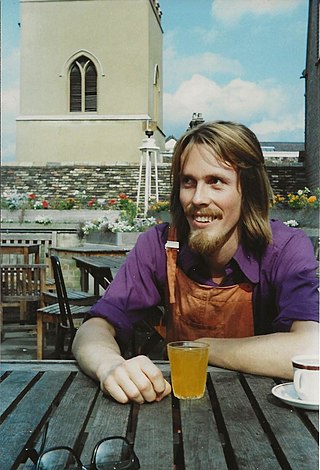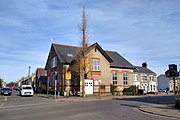
Cambridgeshire is a ceremonial county in the East of England. It is bordered by Lincolnshire to the north, Norfolk to the north-east, Suffolk to the east, Essex and Hertfordshire to the south, and Bedfordshire and Northamptonshire to the west. The largest settlement is the city of Peterborough, and the city of Cambridge is the county town.

Peterborough is a cathedral city in the City of Peterborough district in the ceremonial county of Cambridgeshire, England. For centuries, the city and many of its surrounding villages formed the Soke of Peterborough, in the historic county of Northamptonshire. The Soke of Peterborough had an independent county council, based in the city, between 1889 and 1965. After the Soke of Peterborough was abolished in 1965, the city formed part of the short-lived Huntingdon and Peterborough until 1974. Though the city has a long history as part of Northamptonshire, the city has been part of Cambridgeshire since 1974, and is the largest settlement in that county.

Cambridge is a city and non-metropolitan district in the county of Cambridgeshire, England. It is the county town of Cambridgeshire and is located on the River Cam, 55 miles (89 km) north of London. As of the 2021 United Kingdom census, the population of the City of Cambridge was 145,700; the population of the wider built-up area was 181,137. Cambridge became an important trading centre during the Roman and Viking ages, and there is archaeological evidence of settlement in the area as early as the Bronze Age. The first town charters were granted in the 12th century, although modern city status was not officially conferred until 1951.

East Anglia is an area in the East of England, often defined as including the counties of Norfolk, Suffolk and Cambridgeshire. The name derives from the Anglo-Saxon kingdom of the East Angles, a people whose name originated in Anglia, in what is now Northern Germany.

The East of England is one of the nine official regions of England in the United Kingdom. This region was created in 1994 and was adopted for statistics purposes from 1999. It includes the ceremonial counties of Bedfordshire, Cambridgeshire, Essex, Hertfordshire, Norfolk and Suffolk. Essex has the highest population in the region.

Anglia Ruskin University (ARU) is a public university in East Anglia, United Kingdom. Its origins are in the Cambridge School of Art (CSA), founded by William John Beamont, a Fellow of Trinity College at University of Cambridge, in 1858. It became a university in 1992, and was renamed after John Ruskin, the Oxford University professor and author, in 2005. Ruskin gave the inauguration speech of the Cambridge School of Art in 1858. It is one of the "post-1992 universities". The motto of the university is in Latin Excellentia per societatem, in English Excellence through partnership.

St Ives is a medieval market town and civil parish in the Huntingdonshire district in Cambridgeshire, England, 5 miles (8 km) east of Huntingdon and 12 miles (19 km) north-west of Cambridge. St Ives is historically in the county of Huntingdonshire.

Wisbech is a market town, inland port and civil parish in the Fenland district in Cambridgeshire, England. In 2011 it had a population of 31,573. The town lies in the far north-east of Cambridgeshire, bordering Norfolk and only 5 miles (8 km) south of Lincolnshire. The tidal River Nene running through the town is spanned by two road bridges. Wisbech is in the Isle of Ely and has been described as "the Capital of The Fens".

Romsey is a town in the Test Valley district of Hampshire, England. The town is situated 7 miles (11 km) northwest of Southampton, 11 miles (18 km) southwest of Winchester and 17 miles (27 km) southeast of Salisbury. It sits on the outskirts of the New Forest, just over 3 miles (4.8 km) northeast of its eastern edge. The population of Romsey was 14,768 at the 2011 census.

Godmanchester is a town and civil parish in the Huntingdonshire district of Cambridgeshire, England. It is separated from Huntingdon, 1 mile (1.6 km) to the north, by the valley of the River Great Ouse. Being on the Roman road network, the town has a long history. It has a waterside location, surrounded by open countryside of high value for its biodiversity but it remains highly accessible, with a railway line to London, the A1 road and M11/A14 which run nearby.

Cambridgeshire Constabulary is the local territorial police force that covers the county of Cambridgeshire and Peterborough unitary authority. It provides law enforcement and security for an area of 1,311 square miles (3,400 km2) and population of 856,000 people, in a predominantly rural county. The force of Cambridgeshire includes the cities of Cambridge, Ely and Peterborough, the market towns of Chatteris, Huntingdon, March, Ramsey, St Ives, St Neots, Whittlesey, and town and Port of Wisbech. Its emblem is a crowned Brunswick star containing the heraldic badge of Cambridgeshire County Council.

The West Anglia Main Line is one of the two main line railways that operate out of Liverpool Street. It runs generally north through Cheshunt, Broxbourne, Harlow, Bishop's Stortford and Audley End to Cambridge, with branches between serving Stratford, Hertford and Stansted Airport. The line runs along the boundary between Hertfordshire and Essex for much of its length.
The summer Cambridge Beer Festival is the longest-running CAMRA beer festival in the United Kingdom, having started in 1974. It is held at the end of May just before the Whitsuntide Bank Holiday. The winter beer festival is a smaller, indoor event at the University Social Club, and since 2018 has been held in November. Both festivals are run by Cambridge & District CAMRA. The 2020 festival was cancelled due to the Covid-19 pandemic, and it did not run again until 2023.

Little Thetford is a small village in the civil parish of Thetford, 3 miles (5 km) south of Ely in Cambridgeshire, England, about 76 miles (122 km) by road from London. The village is built on a boulder clay island surrounded by flat fenland countryside, typical of settlements in this part of the East of England.

Haverhill railway station was a station in Haverhill, Suffolk, on the Stour Valley Railway, which opened in 1865 and closed in 1967. It was sometimes known as Haverhill North because of a separate station in the town on the Colne Valley and Halstead Railway.

Ely is a cathedral city and civil parish in the East Cambridgeshire district of Cambridgeshire, England, about 14 miles (23 km) north-northeast of Cambridge, 24 miles (39 km) south east of Peterborough and 80 miles (130 km) from London. As of the 2021 census, Ely is recorded as having a population of 19,200.

Wandlebury Hill Fort, also known as the Wandlebury Ring, is an Iron Age hillfort located on Wandlebury Hill in the Gog Magog Hills, Cambridgeshire, England, to the southeast of Cambridge. Now a country park, it was the most important of three hillforts in the downs.

Clara Dorothea Rackham née Tabor was an English feminist and politician active in the women's suffrage movement, the Women's Co-operative Guild, the peace movement, adult education, family planning and the labour movement. She was a pioneering magistrate, Poor Law Guardian, educator, anti-poverty campaigner and penal reformer in Cambridge where she was a long-serving city and county councillor. Rackham was vice-chairman of Cambridgeshire County Council from 1956 to 1958 and chairman of the Cambridgeshire County Council Education Committee from 1945 to 1957. She first came to prominence through her leading role in the National Union of Women's Suffrage Societies and later became a significant national figure in the labour movement, acquiring a national reputation for her expertise on factory conditions, workers' rights, equal pay, and national insurance.

The following is a timeline of the history of the city of Cambridge, England.

Allan Brigham (1951–2020) was a British road sweeper, historian, and tour guide. His historical writing includes Bringing It All Back Home (2006), a report published by the Chartered Institute of Housing, lamenting the decline of the Romsey neighbourhood of Cambridge, and his many contributions as a founder member of the Mill Road History Project, funded by the National Lottery Heritage Fund in 2013. His honours include a Tidy Britain Group Silver Broom award and an honorary degree from the University of Cambridge.
























